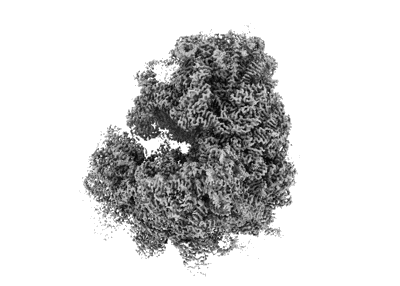EMD-36180
Structure of the Human cytoplasmic Ribosome with human tRNA Tyr(GalQ34) and mRNA(UAU) (non-rotated state)
EMD-36180
Single-particle2.42 Å
 Deposition: 14/05/2023
Deposition: 14/05/2023Map released: 06/12/2023
Last modified: 27/12/2023
Sample Organism:
Homo sapiens
Sample: The complex of Human 80S Ribosome with mRNA and P- site tRNA
Fitted models: 8jdl (Avg. Q-score: 0.573)
Deposition Authors: Ishiguro K, Yokoyama T ,
Shirouzu M,
Suzuki T
,
Shirouzu M,
Suzuki T
Sample: The complex of Human 80S Ribosome with mRNA and P- site tRNA
Fitted models: 8jdl (Avg. Q-score: 0.573)
Deposition Authors: Ishiguro K, Yokoyama T
 ,
Shirouzu M,
Suzuki T
,
Shirouzu M,
Suzuki T
Glycosylated queuosines in tRNAs optimize translational rate and post-embryonic growth.
Zhao X  ,
Ma D,
Ishiguro K,
Saito H,
Akichika S
,
Ma D,
Ishiguro K,
Saito H,
Akichika S  ,
Matsuzawa I,
Mito M,
Irie T,
Ishibashi K
,
Matsuzawa I,
Mito M,
Irie T,
Ishibashi K  ,
Wakabayashi K,
Sakaguchi Y,
Yokoyama T
,
Wakabayashi K,
Sakaguchi Y,
Yokoyama T  ,
Mishima Y,
Shirouzu M,
Iwasaki S
,
Mishima Y,
Shirouzu M,
Iwasaki S  ,
Suzuki T,
Suzuki T
,
Suzuki T,
Suzuki T
(2023) Cell , 186 , 5517
 ,
Ma D,
Ishiguro K,
Saito H,
Akichika S
,
Ma D,
Ishiguro K,
Saito H,
Akichika S  ,
Matsuzawa I,
Mito M,
Irie T,
Ishibashi K
,
Matsuzawa I,
Mito M,
Irie T,
Ishibashi K  ,
Wakabayashi K,
Sakaguchi Y,
Yokoyama T
,
Wakabayashi K,
Sakaguchi Y,
Yokoyama T  ,
Mishima Y,
Shirouzu M,
Iwasaki S
,
Mishima Y,
Shirouzu M,
Iwasaki S  ,
Suzuki T,
Suzuki T
,
Suzuki T,
Suzuki T
(2023) Cell , 186 , 5517
Abstract:
Transfer RNA (tRNA) modifications are critical for protein synthesis. Queuosine (Q), a 7-deaza-guanosine derivative, is present in tRNA anticodons. In vertebrate tRNAs for Tyr and Asp, Q is further glycosylated with galactose and mannose to generate galQ and manQ, respectively. However, biogenesis and physiological relevance of Q-glycosylation remain poorly understood. Here, we biochemically identified two RNA glycosylases, QTGAL and QTMAN, and successfully reconstituted Q-glycosylation of tRNAs using nucleotide diphosphate sugars. Ribosome profiling of knockout cells revealed that Q-glycosylation slowed down elongation at cognate codons, UAC and GAC (GAU), respectively. We also found that galactosylation of Q suppresses stop codon readthrough. Moreover, protein aggregates increased in cells lacking Q-glycosylation, indicating that Q-glycosylation contributes to proteostasis. Cryo-EM of human ribosome-tRNA complex revealed the molecular basis of codon recognition regulated by Q-glycosylations. Furthermore, zebrafish qtgal and qtman knockout lines displayed shortened body length, implying that Q-glycosylation is required for post-embryonic growth in vertebrates.
Transfer RNA (tRNA) modifications are critical for protein synthesis. Queuosine (Q), a 7-deaza-guanosine derivative, is present in tRNA anticodons. In vertebrate tRNAs for Tyr and Asp, Q is further glycosylated with galactose and mannose to generate galQ and manQ, respectively. However, biogenesis and physiological relevance of Q-glycosylation remain poorly understood. Here, we biochemically identified two RNA glycosylases, QTGAL and QTMAN, and successfully reconstituted Q-glycosylation of tRNAs using nucleotide diphosphate sugars. Ribosome profiling of knockout cells revealed that Q-glycosylation slowed down elongation at cognate codons, UAC and GAC (GAU), respectively. We also found that galactosylation of Q suppresses stop codon readthrough. Moreover, protein aggregates increased in cells lacking Q-glycosylation, indicating that Q-glycosylation contributes to proteostasis. Cryo-EM of human ribosome-tRNA complex revealed the molecular basis of codon recognition regulated by Q-glycosylations. Furthermore, zebrafish qtgal and qtman knockout lines displayed shortened body length, implying that Q-glycosylation is required for post-embryonic growth in vertebrates.
